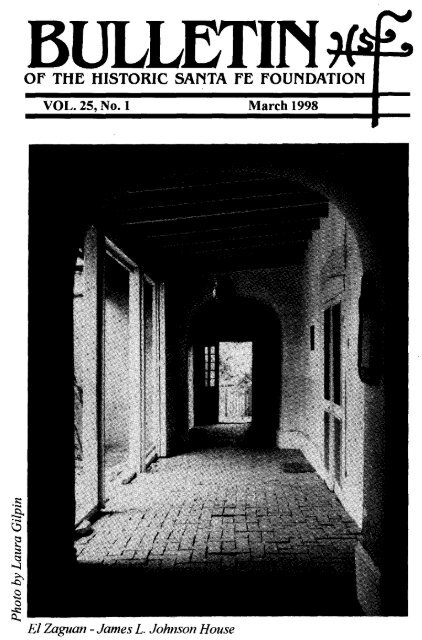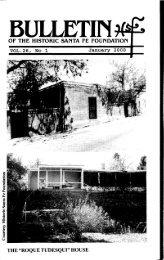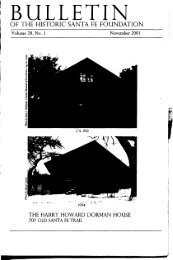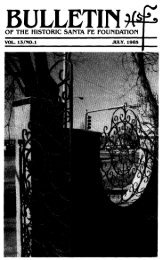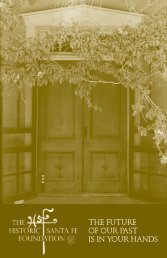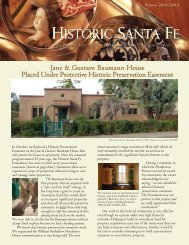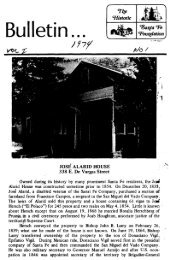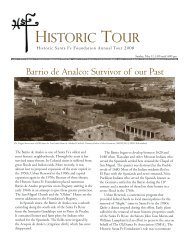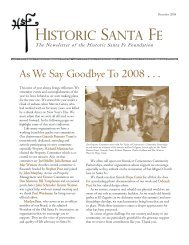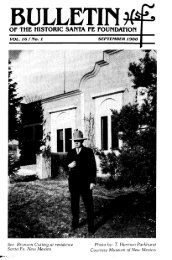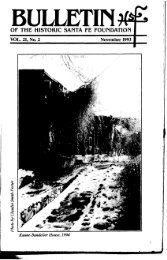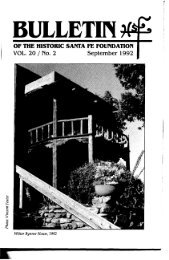James L. Johnson House - Historic Santa Fe Foundation
James L. Johnson House - Historic Santa Fe Foundation
James L. Johnson House - Historic Santa Fe Foundation
Create successful ePaper yourself
Turn your PDF publications into a flip-book with our unique Google optimized e-Paper software.
BULLETIN<br />
OF THE HISTORIC SANTA FE FOUNDATION<br />
VOL. 25, No.1<br />
March 1998<br />
:.::<br />
:§.<br />
CS<br />
~<br />
;:<br />
t:l<br />
~<br />
S<br />
,9 c<br />
~<br />
EI Zaguan -<strong>James</strong> L. <strong>Johnson</strong> <strong>House</strong>
THE JAMES L. JOHNSON HOUSE (EL ZAGUAN)<br />
545 Canyon Road<br />
Corinne P. Sze, Ph.D.<br />
Although the <strong>Historic</strong> <strong>Santa</strong> <strong>Fe</strong> <strong>Foundation</strong> has owned El Zaguan since<br />
1962, existing documentation on the building and its inhabitants was long<br />
recognized to be very limited and, as it turned out, was not entirely accurate.<br />
In order to provide solid documentation of both the history of the<br />
building and its present condition, the "<strong>Foundation</strong>:S Board of Directors<br />
assembled a team that included among others an architect, a preservation<br />
specialist, and myselj as historian, to produce a <strong>Historic</strong> Structures Report<br />
(HSR). This document is intended to guide future decisions related to<br />
the building:S preservation.<br />
What follows is a summary of my research, which was based primarily<br />
on documentary and oral sources. The complete HSR contains an architectural<br />
description, documentation of architectural features, and treatment<br />
recommendations. The complete and annotated history of the building<br />
and its occupants has recently been published by the <strong>Foundation</strong> as a<br />
separate monograph.<br />
The building we have today, known as El Zaguan, was created in the<br />
mid-nineteenth century by <strong>James</strong> L. <strong>Johnson</strong> as a home for his large family.<br />
The son of a lawyer and a Baptist clergyman's daughter, <strong>Johnson</strong> was from<br />
a prominent family with roots going back to seventeenth century Colonial<br />
Maryland. A great uncle was a member of the Continental Congress and<br />
Maryland's first state governor. His father's cousin, Louisa <strong>Johnson</strong>, married<br />
John Quincy Adams. <strong>James</strong> <strong>Johnson</strong> became one of <strong>Santa</strong> <strong>Fe</strong>'s most<br />
prosperous wholesale and retail merchants in the days of the <strong>Santa</strong> <strong>Fe</strong> Trail.<br />
<strong>Johnson</strong> first came to New Mexico in 1845, the year before Colonel (soon<br />
General) Stephen Watts Kearny led the Army of the West to seize New<br />
Mexico near the onset of the Mexican War. (Congress created the Territory<br />
of New Mexico in 1850.) <strong>Johnson</strong> eventually joined Preston Beck, Jr. as a<br />
junior partner in one of the oldest established wholesale and retail businesses<br />
in <strong>Santa</strong> <strong>Fe</strong>. In addition to being the territorial capital, <strong>Santa</strong> <strong>Fe</strong> was<br />
a major trade center until bypassed by the main line of the Atchison, Topeka,<br />
and <strong>Santa</strong> <strong>Fe</strong> Railway in 1880. After Beck's violent death, <strong>Johnson</strong><br />
took over the firm and eventually became the owner of the substantial<br />
business block Beck had built on the northeast comer of the Plaza, where
the Catron Block is today. By the<br />
1870s <strong>James</strong> <strong>Johnson</strong> was one of<br />
the region's most successful merchants.<br />
He had extensive land<br />
holdings around <strong>Santa</strong> <strong>Fe</strong> and<br />
throughout the territory and was<br />
involved in most of the important<br />
business activities of the<br />
day-wholesale and retail trade,<br />
real estate, banking, and mining.<br />
However, in 1881 he suffered a<br />
major reversal of fortune, possiblythe<br />
resuh of new credit realities<br />
which came with the railroad.<br />
With his wife, Maria Jesus<br />
(Jesusita) Montoya of Chihuahua,<br />
Mexico, <strong>Johnson</strong> raised a<br />
family of seven children at their<br />
Canyon Road home. Beginning<br />
in 1854, the year before joining<br />
<strong>James</strong> L. <strong>Johnson</strong>,<br />
Beck's firm, <strong>Johnson</strong> purchased<br />
Courtsy Museum o/New Mexico No.165641 several parcels of land on the<br />
north side of Canyon Road, an<br />
ancient trail up the <strong>Santa</strong> <strong>Fe</strong> River Canyon. He chose a location that was<br />
somewhat removed from the Plaza, the main center of activity. It was a<br />
sparsely populated area amid fields cuhivated by Spanish families, as it<br />
had been one hundred years earlier when the Urrutia Map (c. 1766) was<br />
drawn. <strong>Johnson</strong>'s first tract, purchased from Juan Bautista Moya, contained<br />
a house of an unspecified number of rooms and a corral. He enlarged this<br />
property with additional purchases in 1857, 1864, and 1875 and buih a<br />
sizable Territorial-style home for his growing family, probably incorporating<br />
existing rooms. He eventually owned a large tract opposite on the south<br />
side of Canyon Road, which contained orchards, stables and outbuildings.<br />
As a result of the 1881 financial crisis, <strong>Johnson</strong> lost his home and all the<br />
Canyon Road property, his business block on the Plaza, and other significant<br />
properties to Thomas B. Catron, the powerful <strong>Santa</strong> <strong>Fe</strong> lawyer and<br />
politician. The business was never recouped and members of the family<br />
lived on Canyon Road as Catron's tenants into the twentieth century. In<br />
<strong>Johnson</strong>'s later years, the family formed a friendship with Adolph Bandelier,
the pioneering ethnographer of the Southwest, who was living in <strong>Santa</strong> <strong>Fe</strong><br />
in straitened financial circumstances. Although Bandelier spent his fmal<br />
year in <strong>Santa</strong> <strong>Fe</strong> (1891-1892) as a guest at the <strong>Johnson</strong> home, there is no<br />
evidence, even in the journals Bandelier kept at the time, for the attractive<br />
belief he designed the garden at the <strong>Johnson</strong> home.<br />
<strong>Johnson</strong>'s career and those of his associates illuminate the precarious life<br />
of a frontier merchant with its inherent dangers, both physical and financial.<br />
Nevertheless, his life has been little studied, partly because it was<br />
anomalous with his competitors. Unlike other settled traders, his business<br />
did not survive the end of the <strong>Santa</strong> <strong>Fe</strong> Trail. Instead, <strong>Johnson</strong> faded from<br />
the business world just as a new era was beginning and was lost sight of<br />
even by historians. He also differed from most other <strong>Santa</strong> <strong>Fe</strong> merchants in<br />
a number of defining factors: his place of origin, his family background, his<br />
marriage to a woman from Mexico, his isolation from other members of his<br />
own family, his choice to build an adobe home in an outlying Spanish neighborhood,<br />
and finally the fact<br />
that he established deep roots<br />
in his adopted home and has<br />
many descendents still living<br />
in <strong>Santa</strong> <strong>Fe</strong>.<br />
In contrast to <strong>Johnson</strong>,<br />
other successful merchants of<br />
the <strong>Santa</strong> <strong>Fe</strong> Trail period and<br />
beyond, for example the<br />
Spiegelberg brothers, their<br />
cousins the Staabs, and the<br />
Seligmans, were recent immigrants<br />
to America, primarily<br />
from Germany and of Jewish<br />
origin. They often came in Antoinette Baca (left) and friends, 1920<br />
pairs of brothers --there were Courtesy Frances Baca<br />
six Spiegelbergs at various<br />
times in the <strong>Santa</strong> <strong>Fe</strong> trade; and they tended to return to Europe or to the<br />
East to marry. Their homes were near the Plaza, on newly fashionable streets<br />
such as East Palace Avenue, and designed in imported styles derived from<br />
Europe, such as the Mansard-roofed Staab Mansion now incorporated into<br />
a hotel. Most eventually went back to the East Coast or to Europe to live<br />
out their lives. It is this prominent and distinctive group of merchants who<br />
have received the attention of historians. 1 <strong>Johnson</strong> has been almost completely<br />
ignored.2
The <strong>Johnson</strong> home returned to the family when <strong>James</strong> <strong>Johnson</strong>'s grand<br />
son, <strong>James</strong> Baca, purchased it from the Catrons in 1918. Baca made exten·<br />
sive renovations, apparently turning the house into apartments. However<br />
he borrowed heavily on the property and incurred several mechanic's liens<br />
In the process he lost the property to Bronson Cutting, who took over thl<br />
debt. Cutting, the wealthy owner ofthe <strong>Santa</strong> <strong>Fe</strong> New Mexican and late]<br />
U.S. senator, was a close associate of Baca's brother, Jesus Maria Baca<br />
who inherited the newspaper upon Cutting's premature death in 1935. Ir<br />
1928 Cutting sold the <strong>Johnson</strong> house to Margretta Dietrich, who alread)<br />
owned the property next door on the west.<br />
In the early decades of the twentieth century, <strong>Santa</strong> <strong>Fe</strong> and its nativl<br />
cultures had been discovered by artists, writers, archaeologists, and an·<br />
thropologists. A lively art colony formed in the Canyon Road and the Carnine<br />
del Monte Sol neighborhoods. Far from eschewing adobe architecture, whid<br />
had been consistently reviled by newcomers from the States throughout thl<br />
long Territorial period, this new group bought or built themselves hand·<br />
made adobe houses in Spanish neighborhoods. Civic leaders too, followin~<br />
the lead of the railroad promoters, came to recognize the economic value oj<br />
tourism attracted by history as expressed in local architecture.<br />
<strong>Johnson</strong> s residence on Canyon Road before 1909<br />
Courtesy Museum of New Mexico No. 31821
Once statehood was attained<br />
in 1912, after a decades-long<br />
struggle, an unlikely<br />
alliance of archaeologists,<br />
artists, and business<br />
leaders took up the task of defming<br />
an authentic, "indigenous"<br />
architecture for <strong>Santa</strong><br />
<strong>Fe</strong>. They joined to convince<br />
the citizenry of the appropriateness<br />
and economic advantage<br />
of retaining, restoring,<br />
and, recreating a distinctly<br />
local style in both domestic<br />
and commercial architecture.<br />
The New-Old <strong>Santa</strong> <strong>Fe</strong> Exhibition<br />
held in 1912 brought<br />
the "<strong>Santa</strong> <strong>Fe</strong> Style," as it was<br />
then called, convincingly to a<br />
public audience. It was the<br />
turning point in a movement<br />
which largely created the architecture<br />
of <strong>Santa</strong> <strong>Fe</strong> today. A,fargretla Stewart Die1ri~h<br />
N . Courtesy State Records Center<br />
o one was more Important .<br />
in advancing this architectural<br />
transformation than John Gaw Meem, who came to <strong>Santa</strong> <strong>Fe</strong> for tuberculosis<br />
treatment in 1920 without architectural experience. He went on<br />
to become the premier architect in the Spanish-Pueblo Revival and Territorial<br />
Revival, as the historically appropriate styles came to be called. He was<br />
a leader in the effort to enact <strong>Santa</strong> <strong>Fe</strong>'s first <strong>Historic</strong> Styles Ordinance in<br />
1957 which mandated the use of the historic styles.<br />
Along with artists and scholars, <strong>Santa</strong> <strong>Fe</strong> attracted wealthy patrons who<br />
applied to varying degrees their time, energy, and financial resources to the<br />
preservation of <strong>Santa</strong> <strong>Fe</strong>'s pre-American cultures in all of their expressions.<br />
Among these can be numbered Margretta Stewart Dietrich. Some of<br />
the others were the White sisters, Amelia and Martha; Eva Scott <strong>Fe</strong>nyes,<br />
her daughter Leonora Curtin, and granddaughter, also Leonora Curtin (later<br />
Paloheimo); and the William Fields with their daughter Lois.<br />
Dietrich, the daughter of a Philadelphia physician, was a Bryn Mawr<br />
graduate and the wealthy widow of a former Nebraska governor and United
States senator. She came to <strong>Santa</strong> <strong>Fe</strong> with an impressive record ofpubli<br />
service on behalf of the most vulnerable in society as she had known itwomen,<br />
children, and the aged. She had been a state and national leader i<br />
the woman's suffrage movement, and once the right to vote was won, th<br />
first president of the Nebraska League of Women Voters and regional direc<br />
tor of the National League. In New Mexico she turned her attention to th<br />
problems of Indian peoples. As president of the New Mexico Associatiol<br />
on Indian Affairs from 1934 to 1952, she firmly steered the organization ~<br />
defense of Indian rights for the betterment of their lives and the preservatiOi<br />
of traditional cultures. She herself amassed a definitive collection of con<br />
temporary<br />
Indian painting to become a noted expert on the subject.<br />
Dietrich moved to <strong>Santa</strong> <strong>Fe</strong> in 1927 with her sister, Dorothy Stewart, ar<br />
artist, and bought the Juan Jose Prada house on Canyon Road, her home fOJ<br />
the rest of her life. Soon she felt impelled by threatened development tc<br />
purchase the <strong>Johnson</strong> property next door, to which she gave the name E<br />
Zaguan. Later she purchased the Borrego house, further east on Canyor<br />
Road. All three Canyon Road properties were restored under the directior<br />
of her friend Kate Chapman, who championed traditional builders and theil<br />
methods. Athough Chapman built or restored many houses and was a ma·<br />
jor influence on <strong>Santa</strong> <strong>Fe</strong> architecture from the time of the New-Old Sant2<br />
<strong>Fe</strong> Exhibition, her achievements, like <strong>Johnson</strong>'s, are little recognized today
After Dietrich's death in 1961, EI Zaguan was sold by her executors to<br />
EI Zaguan, Inc., a for-profit corporation set up under the leadership of John<br />
Gaw Meem expressly for the purpose of preserving EI Zaguan. By 1979 the<br />
last shares of this corporation had been transferred to the nonprofit <strong>Historic</strong><br />
<strong>Santa</strong> <strong>Fe</strong> <strong>Foundation</strong>, which still owns and maintains El Zaguan.<br />
The <strong>Johnson</strong> <strong>House</strong> is an excellent example of a Territorial-style home<br />
on one of <strong>Santa</strong> <strong>Fe</strong>'s oldest streets. Also on the property is a well-preserved<br />
section of a major acequia, known as the Canyon Road Community Ditch<br />
(Ditch #15), which diverted water from and returned it to the <strong>Santa</strong> <strong>Fe</strong><br />
River. Its path in 1854 served as the north and west boundaries of <strong>Johnson</strong>'s<br />
first tract of this property, and the north boundary of the parcel added in<br />
1857. Also significant on the property is the recreated Victorian garden,<br />
which, even ifnot originally designed by Bandelier, was a noteworthy feature<br />
in the time of the <strong>Johnson</strong>s. Having survived the financial vicissitudes<br />
of <strong>James</strong> <strong>Johnson</strong> and his grandson, <strong>James</strong> Baca, the property was restored<br />
under the guidance of Kate Chapman in accordance with the best preservation<br />
standards ofthe time. It remains today under the stewardship of the<br />
<strong>Historic</strong> <strong>Santa</strong> <strong>Fe</strong> <strong>Foundation</strong>, the leading private preservation organization<br />
in <strong>Santa</strong> <strong>Fe</strong>. The history of EI Zaguan reflects the major movements of<br />
<strong>Santa</strong> <strong>Fe</strong> social and architectural history in the nineteenth and twentieth<br />
centuries. It touches a wide spectrum of the personalities and events that<br />
make up that history.<br />
ENDNOTES<br />
1. For example, William 1. Parish, "The German Jev, and the Commercial Revolution<br />
in Territorial New Mexico, 1850-1900," ,Yew Mexico <strong>Historic</strong>al Review<br />
35.1 (January 1960) 1-29; 35.2 (April1960) 129-150. Floyd S. Fierman has<br />
wTitten a number of monographs and articles on Jewish merchants in the Southwest.<br />
2 The recently published correspondence of John M. Kingsbury with <strong>James</strong> 1.<br />
Webb in 1853-1861 contains several brief mentions of <strong>Johnson</strong> and more generally<br />
sheds considerable light on business activity in this early period, which<br />
involved many transient merchants, who like Webb and Kingsbury did not remain<br />
in <strong>Santa</strong> <strong>Fe</strong> long into the 1860s to establish large, permanent retail and<br />
wholesale establishments. Jane Lenz Elder and David 1. Weber, eds., Trading<br />
in <strong>Santa</strong> <strong>Fe</strong>: John A1. Kingsbury:y Correspondence with <strong>James</strong> Josiah Hebb,<br />
1853-1861 (Dallas: Southern Methodist University Press, 1996).
DIARY OF AN OLD HOUSE<br />
Excerpts from the Journals of Charlotte White<br />
Edited by Corinne P &e<br />
The last issue of the Bulletin (March 1997) began a series of<br />
excerpts from thejournals Charlotte White began on July 28, 1959,<br />
when she and Boris Gilbertson arrived from Illinois to spend a<br />
month s vacation working on their property at 518 Alto Street. In<br />
this episode, they complete the first month s stay. The following<br />
May they will return to stay. Charlotte s present-day comments<br />
are in brackets.<br />
August 13, 1959<br />
The sheep herder is with<br />
us again. When he is here,<br />
he really works but certainly<br />
not pleasant to have around.<br />
Got another lead on a man<br />
for adobe work. Now to<br />
start trying to find him,<br />
through brother, cousins,<br />
and so forth.<br />
August 16,1959 (Sunday)<br />
Today we have a jack<br />
hammer. Mr. Roybal next<br />
doorwousfurtheciryand<br />
he got a hold of a city one Charlotte White<br />
and is helping Boris crack Photographer, Jesse Monfort Bopp<br />
the stuff up. Why they put<br />
such thick steps in, I can't imagine. It's a terrific job and hope<br />
Boris doesn't overdo. He's really remarkable to be able to throw<br />
that big thing around and know where and how to throw it. And<br />
also to do the beautifully delicate drawings he does, amazing. [When<br />
we came, there were narrow cement steps that Bill Lumpkins had<br />
put in up to the front door. We couldn ~ have that, so Boris is<br />
taking them out.}<br />
Last night we took three children to the circus. I don't know who<br />
had the most fun-the children watching the circus or us watching<br />
the children watching the circus. We had cotton candy and bal-
loons. There were lots of animals, for which I'm glad. The most<br />
wonderful to me were the trained chimps, which I howled over.<br />
Duchess liked the elephants best.<br />
The adobes are almost where we want them. The windows are<br />
sealed with mortar and new lintels. Boris has really been working<br />
like an ox. It's remarkable how he takes it.<br />
August 18, 1959<br />
We have a good floor; that we knOw. The jack hammer wouldn't<br />
even break it up. Just made little holes in it. It's poured concrete<br />
over wire mesh. We had to tunnel under it and then break it to get<br />
our zaguan. The front is going to look quite different with the big<br />
drive fup to the door], which the sheep herder and Boris are digging<br />
out. What a job and what mess.<br />
[That s the cement floor between the bathroom and the east wall<br />
of the front room. Lumpkins had created an inside hallway with a<br />
plasterboard partition that continued the south wall of the front<br />
room across to the bathroom, which he had added. This arrangement<br />
took away the zaguanfeeling. We took the partition andfloor<br />
out. Later we took dirt out. The whole thing was unbelievable.]<br />
Boris made a little pinon<br />
"stove" in the patio to cook on,<br />
cheaper than charcoal, and I think<br />
I'll like it better. It is easier to<br />
regulate the heat. {This was just<br />
a rock enclosed area for ajire. j<br />
We only have about ten more<br />
days here. How quickly a month<br />
has gone and not nearly as much<br />
Boris Gilbertson<br />
done as hoped. Hate leaving it.<br />
Courtesy Charlotte White<br />
Hope it won't be long before we<br />
get back.<br />
August 19, 1959<br />
Signed my will today leaving everything to Boris. He is to distribute<br />
some of my personal belongings as I desire. It's simpler and<br />
cheaper that way.<br />
Today I can't use the bathroom for our sheep herder is tunneling<br />
and breaking up the floor in the front [hallway]. It will be a feat to
even use it when it's available. Need a ladder. Love mypiiion stove,<br />
and it's so nice to have the campfire going at night. Got some<br />
marshmallows; the children have never roasted them.<br />
Never have we seen so many men looking for work and yet so<br />
hard to find anyone to work. They're all like Mike, I guess: They<br />
love the idea of earning some money but not willing to do anything<br />
for it. Ambrosio is really a good worker, poor guy. It's heavy work,<br />
too. Was offered $35,000 yesterday for the place when it's finished-not<br />
interested.<br />
August 22, 1959<br />
Siempre manana. Still seem to be always waiting for something<br />
to get done. Now it's to have a mountain of sand, stones, and cement<br />
hauled away by Rios wood yard where I buy two laundry<br />
tubs of wood for sixty cents. It would be wonderful fill, but of<br />
course now no one wants it.<br />
The front is really beginning to look elegant. It looks so tall and<br />
grand. The idea of "friend" Delfino Montoya wanting $5.00 per<br />
hour has spurred us on. That was with Montoya's brother-in-law<br />
as helper which we certainly don't need. We told him no, and Boris<br />
will do it himself. There! Since I have no pen and the candle is<br />
insufficient light, I'll wait until manana.<br />
August 24,1959<br />
How quickly the days go by, unbelievable. Such a busy place<br />
this is. Rios never did show up, so told him not to bother. Got the<br />
Senas. A thirteen-year-old boy drives the truck and helps his very<br />
handsome grandfather-I'm sure he isn't fifty, if that. Our helper<br />
is bringing adobes inside for safe keeping through the winter. Boris<br />
busy laying up adobes and I'm still scraping paint from old doors.<br />
Took my little girls shopping this moming. Yesterday was Duchy's<br />
birthday so told her I'd get her a fancy hat to wear to church. All<br />
the little girls have them and they look like birthday cakes. Also one<br />
for Juanita-I won't be here for her birthday. When we get to town,<br />
we discover without a doubt that a petticoat would be much more<br />
exciting, so they chose red tulle with red ribbons and bells around<br />
the bottom-very pleased.<br />
Ginger and Charles are coming for dinner-our first dinner<br />
guests. Grilled hamburgers, salad and fruit, roasted marshmallows.<br />
Saved enough for hungry mouths. Four of the children were here<br />
for their first marshmallow roast. What fun!
Got some DDT this morning. Think there must be bedbugs in the<br />
walls. [They loved me; they didn't even touch Boris.j When we<br />
first came I slept on the low cot and every night I'd get bites, so I<br />
changed to the high cot. No bites, nor did Boris on the low one.<br />
Last night they found me on the high one .. Anyway I poured DDT<br />
around the floor and on my cot legs. They can live for years evidently<br />
without nourishment. Wonder if that's it. There was no one<br />
here for years. Anyway, it was awful.<br />
August 25, 1959<br />
Another dark day and rain this morning. Boris has taken off to<br />
the hills for a few hours; we'll see. He couldn't stand it anymore<br />
here, and I can't blame him. He certainly deserves some pleasure<br />
and relaxation. Ambrosio bringing adobe in between showers, cleaning<br />
bricks when it rains. Had tons, five loads, of stuff hauled away,<br />
front and back. Looks much better. Now if the rain will stay away<br />
for a few days.<br />
Work in progress on back wall - Charlotte and faitl!liil Jeep<br />
Courtesy Charlotte White<br />
August 28, 1959<br />
Getting ready to leave our house. Hate the thought. Got all the<br />
adobes inside, the windows boarded up, the front cleaned up, gravel<br />
in the drive. How different and grand it looks. We'll work and live<br />
for the day when we return with bag, baggage, and Mau-Mau [my<br />
parrot}.<br />
August 29, 1959<br />
6 a.m .. leaving. Our children came to say good-bye last night,<br />
and as they left in unison said, "God be with you on your journey. "<br />
I detected tears in their voices. My eyes had some. Hasta la vista.<br />
(['0 BE CONTINUED)
SATURDAY DOCENTS AT EI ZAGUAN<br />
Jim McBride,<br />
Docent Coordinator<br />
Last summer marked the third year the <strong>Foundation</strong> has been able to<br />
provide docents at EI Zaguan from 10 a.m. to 4 p.m. on Saturdays during<br />
July and August. A handful of volunteers welcomed visitors to our<br />
historic home and garden. They talked about <strong>James</strong> L. <strong>Johnson</strong>'s residence,<br />
the garden and territorial <strong>Santa</strong> <strong>Fe</strong> during the early years. Some<br />
of the questions our docents are asked give an excellent idea of the range<br />
of interests the visitors to EI Zaguan have. The most asked questions,<br />
and our answers, were compiled during the eight weeks by the docents.<br />
Most of them will speak for themselves.<br />
What are those two big trees that give the garden so much shade? Horse<br />
chestnut trees, which are said to be over 150 years old.<br />
What does EI Zaguan mean? It is Spanish for covered passageway<br />
or hall connecting rooms or different parts of buildings. Mrs.<br />
Dietrich, who bought the property in the 1920s, gave the structure its<br />
name for the long hall that extends from the garden porch to the east<br />
placita.<br />
How old is this place? We do not know exactly. When <strong>James</strong> <strong>Johnson</strong><br />
purchased some of the land 1854 it had a house and corral on it.<br />
He added more rooms and land over the next twenty years.<br />
What are those trees just inside the entrance called? They are called salt<br />
cedars.<br />
Do you have a public rest room? No, but we allow our visitors to use the<br />
small toilet in the building during these guided tours.<br />
Where can we get something cold to drink? Celebrations restaurant is<br />
just half a block up Canyon Road, on the same side as El Zaguan.<br />
Is any of the furniture original? At present the <strong>Foundation</strong> is attempting<br />
to determine if some of Mrs. Dietrich sfurnishings are on the<br />
property. We know her sister, Dorothy Stewart, one of the artists<br />
who lived on Canyon Road in the 1920s and 1930s, decorated some<br />
furniture for her. Our current apartment tenants furnish their spaces<br />
to their individual taste.<br />
Did other <strong>Santa</strong> <strong>Fe</strong> merchants or businessmen live on Canyon Road? As<br />
far as we know, the majority of the business leaders in the city lived<br />
closer to the downtown area, many of them of Palace Avenue ..
How did <strong>James</strong> <strong>Johnson</strong> furnish the house? Again. we do not know<br />
exactly The house probably wasfurnished with household items of'<br />
his period. which could have been Victorian. We can guess that<br />
there was some local Spanish style jiirniture. since it was both the<br />
custom and because his wife was from Mexico. Unfortunately we do<br />
not have photos of his householdfiirnishings. We knowfrom the<br />
way Mr. <strong>Johnson</strong>frequently remodeled his store building on the<br />
Plaza that he liked to have the latest things. at leastfor his business.<br />
He was reported to have thefirst metal roofin New Mexico on<br />
his store.<br />
When was the garden planted? Records' indicate a garden on the west during<br />
<strong>Johnson</strong> s occupation. What kind of garden we are not sure.<br />
Stephanie Davis recreated our current garden in 1990 in the style of'a<br />
turn-of-the-century Victorian garden.<br />
When was the use of the garden acequia discontinued? In the 1960s it<br />
was deactivated.<br />
How can I rent an apartment? Stop to see our Executive Director<br />
during the week to get all the information on the apartments<br />
and to be included on the waiting list.<br />
How long is the waiting list? very long!<br />
Does the cat belong to the building? Yes, Mischka is as much a part of'<br />
El Zaguan as was her owner. Sylvia Loomis, a resident since<br />
1947 who died in 1994. <strong>Foundation</strong> staff and tenants affend to<br />
the cat now.<br />
Are there any farm animals on the adjoining lands? Asfar as we know<br />
only cats and dogs live around El Zaguan. ..and a pet pig. which<br />
resides in the house to the west of our property.<br />
What is the name of that flower over there in the garden? Here. have a<br />
garden layout sheet. which shows where the different flowers<br />
are located.<br />
Can we sit on the porch in the swing or chairs? Yes. you may Enjoy!<br />
This year's Saturday Docents were Charlotte White, Greg Walke, Don<br />
and Robin Brown, Lynne Andrews, Joyce Remke, Janet Kimberling and<br />
Lois Snyderman.<br />
13
IN MEMORY<br />
This last year the HSFF lost two members of dedication and great<br />
worth. It was considered only appropriate that such special friends be<br />
recognized in this issue.<br />
JULIE PALTENGHE DOUGHERTY Photographer, Hope Curtis<br />
Randy Bell, Past HSFFChair<br />
Julie Paltenghe Dougherty was born on December 27, 1925. On her<br />
mother's side, Julie was a tenth generation New Mexican and on her<br />
father's side, a third. She attended the Loretto Academy, ultimately graduating<br />
from the Radford School in El Paso, Texas. She went on to receive<br />
degrees from Vassar, Columbia University, and Manhattanville College.<br />
Julie returned to New Mexico in 1982, where she established residence<br />
with her husband, William Holmes Dougherty of <strong>Santa</strong> <strong>Fe</strong>. In addition<br />
to her many other interests and activities, Julie traveled extensively in<br />
the Himalayas of Nepal and Pakistan.<br />
Julie was an active HSFF Board member from 1992 to 1996, and<br />
chair of the <strong>Foundation</strong>'s Board from 1995, and served throughout her<br />
board membership as chair of the Education Committee. She will be<br />
remembered by members for her dedication, interest in historic issues,<br />
and service to the <strong>Foundation</strong> her grace, humor, and energy. Shortly<br />
before her untimely death, she told me her involvement with the HSFF<br />
was one of her most rewarding and cherished memories. She will be<br />
greatly missed by her friends and family.
JORDIE CHILSON<br />
Charlotte White. HSFF Member<br />
Jordie Chilson and I were not close friends. Now that she is gone<br />
(alas, too often this is true) I realize our relationship was very warm,<br />
trusting and meaningful. She gave of herself sincerely and faithfully in<br />
many ways. Her volunteer work in the Wheelwright Museum Shop, the<br />
book store of the Palace of the Governors, and her intense contribution<br />
to the <strong>Historic</strong> <strong>Santa</strong> <strong>Fe</strong> <strong>Foundation</strong> as a board member for twelve years<br />
were all indications of how dedicated she was to all she did. The new<br />
wing of the Museum oflndian Arts and Culture contains a replica Navajo<br />
hogan, which was funded from Jordie's estate. As chair for the<br />
HSFF Membership Committee her efforts resulted in the largest membership<br />
the <strong>Foundation</strong> ever had. Her death on <strong>Fe</strong>bruary 26, 1997 is a<br />
loss to us all. We will miss you, Jordie.<br />
Charlotte White and Jordie Chilson<br />
Photographer.<br />
Hope Curtis<br />
1
SANTA FE ARCHITECTURE--1881<br />
Marilyn Manges. Research<br />
VOluntel<br />
This project began with a small article in the <strong>Foundation</strong> Newslettl<br />
requesting volunteers to search back issues of the <strong>Santa</strong> <strong>Fe</strong> New Mex<br />
can for architectural references. The Research Committee had long bee<br />
frustrated by the lack of complete indexing for the <strong>Santa</strong> <strong>Fe</strong> newspll<br />
pers. Since I had some experience in using newspapers for historic"<br />
research, I volunteered with a few other individuals. Each of us took<br />
year that was not indexed, read microfilm and recorded our findings.<br />
Although many interesting references were found, for a variety 0<br />
reasons this phase of the project flagged. Later Corinne Sze called ffiI<br />
when she needed the source of an undated clipping in the FoundatiOl<br />
files regarding El Zaguan. From force of habit, I kept notes on archi<br />
tectural items found during the search. The next request was to uneartl<br />
the obituary of <strong>James</strong> <strong>Johnson</strong>, owner of what was to become El Zaguan<br />
Due to a misunderstanding, I began searching the year 1881. I coule<br />
not find the obituary, but my architectural notes became so copious<br />
that I used a computer program to sort them. At some point a discussion<br />
with Corinne revealed the fact that I was working on the wrong<br />
year. Later the obituary (undated) was found in a scrapbook belonging<br />
to one of the <strong>Johnson</strong> descendants.<br />
Too late to stop, the index was completed. The wrong year proved to<br />
be an interesting one, both historically and architecturally, and provided<br />
a revealing glimpse of a changing city. Building was the order of<br />
the day and the editor of the newspaper gloated as the city became<br />
more "American."<br />
With some exceptions, <strong>Santa</strong> <strong>Fe</strong> was a town of "Wild West" fiction<br />
in 1881. Saloons and billiard halls outnumbered churches and schools.<br />
There were still shootings on the Plaza. Indian bands were a threat to<br />
travelers and desperados were not unknown. One could travel to Chicago<br />
by train but Espanola was served by stagecoach.<br />
Architecturally, most of the city looked as it had before Territorial<br />
days. The typical building was a one-story adobe with a flat roof (which<br />
often leaked). Streets were not paved. There was a serious sewage problem<br />
on Water Street (formerly the Rio Chiquito). Although there were<br />
a few scattered gas lights, the only area with permanent gas lighting<br />
was Fort Marcy, the buildings and grounds, which occupied a good share<br />
of the central part of the city.<br />
16
The Plaza was the center of activity with the governor in residence at<br />
the Palace and with several stores marketing merchandise acquired from<br />
"throughout the world." The Alahambra Saloon and the Exchange Hotel<br />
contributed to the Plaza's ambience. There were shops on San Fran-<br />
Palace Hotel, WashingtonAvenue c.1885<br />
Courtesy New]'lexico No.10763<br />
cisco Street near the Plaza, but lower San Francisco abounded with<br />
saloons. Upper Palace Avenue was the gentrified part of the city.<br />
In spite of the New Mexican boosterism, these were not good days<br />
economically for <strong>Santa</strong> <strong>Fe</strong>. In size it was fourth in the territory, below<br />
Albuquerque, Las Vegas and Taos. The advent ofthe railroad resulted<br />
in a smattering of tourism, including a group of Austrian counts, who<br />
were traveling to visit the Wild West. There was also an influx of investors,<br />
most of whom appeared to be interested in mining.<br />
Nevertheless, a minor building boom was taking place. Spiegelberg's<br />
new store on the south side of the Plaza and the Palace Hotel on Washington<br />
Street, as well as the Staab residence on Palace Avenue, were<br />
built in Anglo-American styles, much to the delight of the New Mexican.<br />
Although the Cathedral was not completed, churches reflecting the<br />
influence of the eastern part of the country flourished. A new Episcopal
church was nearly completed on Palace Avenue. The Presbyterian church<br />
on Grant was remodeled with a new addition. The new Methodist chapel<br />
on West San Francisco resembled a small church in New England and<br />
the Congregationalists started to build a similar structure. English-speaking<br />
Catholics remodeled the Guadalupe church. In addition to this ecclesiastic<br />
construction, there was some development both near the depot<br />
and on the south side of the river, including a brick yard and a cracker<br />
factory.<br />
In general, the goal of city boosters to make <strong>Santa</strong> <strong>Fe</strong> look like the<br />
rest ofthe United States was not yet accomplished, but there were significant<br />
beginnings. For those interested in learning the history of the<br />
city from the perspective of newspaper coverage, volunteering to help<br />
continue this project with the Research Committee can be fun as well as<br />
enlightening.<br />
Spiegelberg Brothers Store - south side Plaza<br />
Courtesy Museum of New Acfexico 111'0.150156
ORPHANS, GHOSTS, AND SEVEN BURROS:<br />
Life in an HSSF plaqued property<br />
Property Owners and Corinne P Sze<br />
In the second of an ongoing series, the owners of the Bronson Cutting<br />
<strong>House</strong> spoke on a summer evening about what it has meant to<br />
them to own a historic house in <strong>Santa</strong> <strong>Fe</strong>. As we sat before the brick<br />
fireplace in Cutting s spacious living room, it was hard to resist thinking<br />
of the history that was made in this home, which Cutting completed<br />
in I911. The wealthy scion of a prominent New York family,<br />
Cutting had come to <strong>Santa</strong> <strong>Fe</strong> the previous year seeking relieffrom a<br />
ruinous case of tuberculosis. Like so many in the same predicament.<br />
he recovered and made <strong>Santa</strong> <strong>Fe</strong> his permanent home. In 1912 he<br />
bought the <strong>Santa</strong> <strong>Fe</strong> New Mexican, and at the time of his premature<br />
death in a 1935 plane crash.hadjust been reelected to represent New<br />
Mexico in the United States Senate. After his death the house was<br />
purchasedfrom the heirs by Cutting s long-time associate, Jesus Maria<br />
Baca, to whom he had willed the New Mexican. Subsequently the<br />
house was used as an orphanage by the Archdiocese of <strong>Santa</strong> <strong>Fe</strong>, and<br />
as the home and office of a physician and then a lawyer. The present<br />
owners and their teenage son became the latest residents of the<br />
Bronson Cutting <strong>House</strong> about five years ago. At their request names<br />
are not used.<br />
Q: How did you come to be in <strong>Santa</strong> <strong>Fe</strong> and in this house?<br />
He: We moved here from Washington, D.C., to fulfill a dream of living in<br />
<strong>Santa</strong> <strong>Fe</strong>. I had first come to the area about 25 years ago as a consultant<br />
to the Navajo tribe. I knew then that I would live here. The<br />
land is very, very spiritual for me.<br />
She:We were looking for a traditional adobe. The real estate agent suggested<br />
we look at this house, although it didn't fit what we said we<br />
wanted. The house has a special feeling; I can't really explain it in<br />
words, but that's what attracted us to it.<br />
Q: What specifically did you like about the house?<br />
She:The living room; the lighting at dusk is magical. Also the privacy and<br />
the fact that we can walk to the Plaza.<br />
Q: Did its history influence your choice?<br />
He:<br />
We were interested in it before we knew anything about the history.<br />
The reahor didn't make a big deal out of its being historic, just pre-
sented that as something we might like to knOw. She did give us the<br />
<strong>Foundation</strong>'s Bulletin on the house and an album of historic photos.<br />
The <strong>Foundation</strong>'s plaque had been removed.<br />
She: What she told us only piqued our interest, but we really bought the<br />
house because we liked it. Only later did the history really mean anything<br />
to us. We had never heard of Bronson Cutting.<br />
Q: Did you have any qualms about buying a historic house in <strong>Santa</strong> <strong>Fe</strong>?<br />
He: We realized from living in Washington there could be considerable<br />
responsibilities. We had never owned a historic house before, but we<br />
weren't worried about it.<br />
We didn't think to ask and<br />
the agent didn't mention any<br />
restrictions or obligations<br />
that historic status might<br />
entail in <strong>Santa</strong> <strong>Fe</strong>. We didn't<br />
find out that this was a review<br />
area for the city until<br />
we hired Sharon Woods as<br />
a contractor.<br />
Q: Was it a problem for you<br />
when you realized there<br />
would be limitations on<br />
what you could do with the<br />
property?<br />
He: Fortunately we did not<br />
anticipate any exterior<br />
changes in mind, but I did<br />
need to convert a 1950s garage<br />
into an office for my<br />
practice. When Sharon .. , -<br />
. Bronson M Cuttmg m front of hiS house<br />
started talkmg about all of Courtesy Museum of New Mexico No. 51499<br />
the requirements we asked<br />
her who she represent. We didn't realize till then she was the chairman<br />
of the city's <strong>Historic</strong> Design Review Board. Sharon was totally straight<br />
about everything. I had never dealt with anything like this before;<br />
some of it seemed arbitrary, but I came to appreciate the process-in<br />
part, because of my growing respect for this house.<br />
Q: How did you become interested in the history of the house?
He: A friend gave us a recent biography of Cutting by Richard Lowitt. At<br />
first I wasn't really that interested in reading the book, but I perused it<br />
for information about our house. Being from Washington, D.C., we<br />
had been surrounded by the world of politics all our lives. But as I<br />
looked through the book I realized that this man was something special,<br />
and I became fascinated by his life and by him as a person.<br />
She: Also, we began to meet people who knew about Cutting or had been to<br />
the house when it was an orphanage, or to see the doctor or the lawyer<br />
who had their offices here at one time.<br />
Q: What especially impressed you about Cutting?<br />
Cutting <strong>House</strong> inside patio and fountain<br />
Courtesy Museum of New 1\1exico No. 47779<br />
He: Of course, he rose high enough in politics during his time in Washington<br />
to be offered the Vice Presidency under Herbert Hoover, and the Secretary<br />
of Interior by<br />
FOR. But what really<br />
impressed me<br />
were his principles<br />
and how he stuck<br />
with them. He sponsored<br />
the Philippine<br />
Independence bill,<br />
helped found the<br />
American Legion,<br />
championed the<br />
rights of the disabled,<br />
and chastised<br />
FOR's public works<br />
programs as too<br />
conservative. He did<br />
more than anyone<br />
else at the time to enfranchise Hispanics in the state. It seems to me that<br />
he lived his values and even spent his own money in support of them.<br />
One example was his sponsorship of Hispanic kids to go to college.<br />
Through the book, I come to admire his character immensely; psychologically<br />
he is interesting to me as a character study of functional narcissism,<br />
a narcissist who learned to make it work.<br />
Q: Did the house hold any other surprises for you?<br />
She: For a house of its size and expense, the detail work doesn't seem as<br />
finely done as you might expect. For example, the brickwork on the<br />
">,
fireplace is not fully consistent and the windows aren't centered. The<br />
plank doors seem too rustic. I don't know if this reflects the state of the<br />
building craft out<br />
here then, economic<br />
restraints<br />
on Cutting's<br />
part, or perhaps<br />
just a conscious<br />
informality.<br />
Also, there is a<br />
mystery about<br />
the drainage system<br />
for the patio<br />
and the fountain.<br />
It is still intact<br />
and works, but<br />
where does the<br />
water go? No one has a clue. There are no pipes in the basement.<br />
He: The realtor said that the manufacturer would be interested in the 1950s<br />
boiler in the basement as a museum piece and would give us a new one<br />
in exchange. It was true! They replaced it, and later a local plumber<br />
reported that he saw the old thing clwlking away at a trade show.<br />
She: After we were living here about a month, the ghost of the house came to<br />
me in a dream and said, "I'm friendly; the house is O.K." A few months<br />
later a psychic friend bumped into a ghost in the hallway. About once<br />
a week the hall lights, which are on a sensor switch that makes them go<br />
on automatically when someone enters the room, turn on at night for<br />
no apparent reason.<br />
Q: Have there been any problems or inconveniences in owning the house?<br />
He: There were no hidden problems, nothing beyond what you would expect<br />
with an old house like wiring, plumbing, and the like. It's a good house,<br />
not drafty, with a lot of passive solar.<br />
She: The first week we were here, a very strange thing happened. My husband<br />
was out of town, and our son was out with friends. There was<br />
nothing on the windows yet, and there I was alone doing dishes on a<br />
summer night, when the door opened. I turned to see a strange woman<br />
standing in the doorway. She announced that she knew we were in the<br />
house, but Don Miller (a previous owner) had sold it to her. "I have the<br />
deed," she said, "and you have to leave." She kept saying the same
thing over and over. Finally I got her to come outside with me and I<br />
suggested that I would get in touch with her in the morning. With that<br />
she left. The policeman who answered my call was skeptical. Two<br />
hours later they picked up a woman in a downtown hotel with a similar<br />
story. Was I relieved!<br />
Q: What changes have you made to the house and has its history influenced<br />
your decisions?<br />
He: We haven't made many really-nothing structural and nothing on the<br />
exterior of the house, which we loved when we bought it. We did modernize<br />
the kitchen and added a ceramic tile mural by Pedro Romero.<br />
We put indoor shutters on the windows in the living room. There is a<br />
stack of original interior doors in the basement, so obviously there has<br />
been a lot of opening up to suit modem tastes. Also, we put in the<br />
fountain that is at the center of the patio. The one Cutting had was long<br />
gone.<br />
She: Early on when we were fixing the kitchen, we considered taking out a<br />
wall. It took our son to remind us that this was a historic house and we<br />
shouldn't make such a drastic change. Our sensibilities have grown as<br />
we have lived in the house, and we wouldn't want to make any major<br />
changes now, even where they are allowed.<br />
Q: Do you have any advice for someone who owns or might contemplate<br />
owning a historic house in <strong>Santa</strong> <strong>Fe</strong>?<br />
She: Be prepared for it to impact you in ways you can't predict. Respect its<br />
history. A historic house imposes its soul as well as its history in special<br />
ways.<br />
Q: Have you any future plans for the house?<br />
He: We are intrigued with the name Cutting gave the house, Los Siete Burros<br />
(The Seven Burros)-with its political resonances. The realtor had<br />
told us about the name, but we only realized its implications when we<br />
read the biography. The "burros" were Cutting and his closest associates,<br />
his "kitchen cabinet." I want to restore the name to the house,<br />
perhaps by having a sign made for the outside. It is important to us to<br />
keep this link with history alive. Can you imagine the political plotting<br />
and scheming that went on here?<br />
Yet we have hardly met a anyone in <strong>Santa</strong> <strong>Fe</strong>, not connected with the<br />
house or a historian, who has heard of Bronson Cutting. It seems a<br />
shame to us that he seems to be forgotten. I want to do more research to
get people together who knew the house and collect their personal histories<br />
to keep with the house. To start we are planning to record an<br />
interview with a neighbor who has been here at least since the 1950s.<br />
He was in the house many times and knows lots of stories. Also, we<br />
received a letter from Cutting's great nephew, and we plan to follow up<br />
on that. It would be fun to have a party and bring all of these people<br />
together.<br />
She: A woman came to the door and woke my son who was in the house<br />
alone. She said she thought she had grown up in the house when it was<br />
an orphanage. He dido't quite know what to do and dido't get a name.<br />
Unfortunately, she never calIed back. Now we know enough that we<br />
want to talk to these people.<br />
Recently an electrician extending the line had to get through a basement<br />
crawl space so low he could barely make it. He discovered that<br />
the crawl space has been used as a dump during construction. It might<br />
be interesting to look into digging that out.<br />
He: We want to honor the history and tradition of this unique man by keeping<br />
the history of the house alive. We have a sense of responsibility and<br />
respect for this house that has only grown as we have lived here and<br />
learned about its history. We feel like keepers of this little comer of<br />
history.<br />
The Bronson M. Cutting <strong>House</strong> was plaqued by the <strong>Foundation</strong> in<br />
1987. and its history published in the September 1988 Bulletin of the<br />
<strong>Historic</strong> <strong>Santa</strong> <strong>Fe</strong> <strong>Foundation</strong>.
SAN ISIDRO FEAST DAY<br />
Eleanor Bove, Board member<br />
On Thursday, May 15, 1997, the community of Cristo Rey Church<br />
came together to honor San Isidro, the patron saint of farmers, on his<br />
feast day. Father Lucero, Pastor of Cristo Rey Church, led the annual<br />
procession, pausing to pray at the headgate of the Acequia Madre. From<br />
the beautifully restored capilla, which sits on a high perch on Cerro<br />
Cordo Road, Father Lucero blessed the fields. The old was mixed with<br />
the new as Carlos and Ruth Martinez introduced an old hymn and<br />
alabados to San Isidro were sung.<br />
Services at San Isidro capilla Cerro Gordo Road<br />
Photographer. Richard Gonzales
HISTORIC PRESERVATION EASEMENTS COME<br />
TO HSFF<br />
Tracey Connor. Board Member<br />
In 1995 the <strong>Historic</strong> <strong>Santa</strong> <strong>Fe</strong> <strong>Foundation</strong> helped shepherd the Cultural<br />
Properties Preservation Easement Act (the "Act") through the state<br />
legislature. The Act enables private citizens to establish historic preservation<br />
easements to protect historic structures, archaeological sites,<br />
cultural landscapes and traditional cultural properties. The <strong>Foundation</strong><br />
has established a program to hold, monitor and enforce historic preservation<br />
easements. Because this program is new to New Mexico, the<br />
<strong>Foundation</strong> is working with property owners, appraisers, accountants<br />
and city planners to educate and assist in understanding the benefits of<br />
these easements and the process of creating them.<br />
A historic preservation easement is a voluntary legal agreement made<br />
by a property owner to protect the unique historic resources on property<br />
by restricting the type and amount of development that may take<br />
place. Each easement's restrictions are tailored to the particular property<br />
and to the interests of the individual owner. The easement creates<br />
permanent legal assurances that the property, even as it passes from<br />
owner to owner, will retain its unique characteristics.<br />
The specific rights a property owner forgoes when granting a historic<br />
preservation easement are spelled out in each easement document. The<br />
owner and the <strong>Foundation</strong> identify the rights and restrictions on use that<br />
are necessary to protect the property. The <strong>Foundation</strong> has the right under<br />
the easement agreement to protect the property. The property periodically<br />
is inspected to ensure compliance with the easement restrictions<br />
and enforcement of the restrictions in the event they are violated.<br />
When a historic preservation easement is granted, the property owner<br />
retains title, and can use, sell, or leave the property to the family. Future<br />
owners of the property must abide by the easement's restrictions.<br />
The easement is recorded at the county recorder's office so that all<br />
future owners and lenders will learn about the easement restrictions.<br />
If the easement donor wishes to qualify for an income tax deduction,<br />
the federal tax laws require some form of public access or public viewing<br />
be available. If the property is an occupied residence, the public<br />
access requirement may be satisfied by allowing the <strong>Foundation</strong> to conduct<br />
two guided tours each year and permit people affiliated with educational,<br />
professional or historical societies to study the property.
The term of an easement may be perpetual, or for a specified number<br />
of years. Only gifts of perpetual easements can qualify a donor for income<br />
and estate tax benefits. Easements may be amended by agreement<br />
between the property owner and the <strong>Foundation</strong>, provided that amendment<br />
is consistent with the purposes of the easement and does not impair<br />
the unique qualities the easement is designed to protect. Easements<br />
may be terminated if there is a change in conditions surrounding the<br />
property which makes the preservation purpose of the easement impossible<br />
to achieve.<br />
The property owner who donates a historic perservation easement may<br />
be eligible for income and estate tax benefits.The donation of an easement<br />
is a tax-deductible charitable gift, provided the easement is perpetual,<br />
designed to preserve an historically or culturally important land<br />
area or building, and donated to a qualified organization. To determine<br />
the value ofthe easement donation, the owner has the property appraised<br />
both at its fair market value without the easement restrictions and at fair<br />
market value with the easement restrictions. The difference between these<br />
two appraised values is the easement value.<br />
An easement may reduce estate taxes. If the property owner has restricted<br />
the property by a perpetual historic preservation easement before<br />
his or her death (or by will), the property must be valued in the<br />
estate at its restricted value. To the extent that the restricted value is<br />
lower than the unrestricted value, the value of the estate will be less,<br />
and the estate will thus be subject to a lower estate tax. For some property<br />
owners, these tax benefits may be sufficient to allow the property<br />
to be retained in the family rather than sold to pay estate tax bills.<br />
<strong>Historic</strong> preservation easements generally do not reduce the assessed<br />
value for property tax purposes, so do not have a negative impact on the<br />
propertytax base. Studies have shown property adjacent to or near easement-protected<br />
property may increase in value.<br />
Because the <strong>Foundation</strong> will incur monitoring and enforcement costs<br />
in holding and monitoring easements, its policy is to ask each easement<br />
donor to make a stewardship contribution to cover these potential<br />
costs. This easement endowment provides assurance to the easement<br />
donor that the property can be protected and preserved in perpetuity.<br />
Please call the <strong>Foundation</strong> office at 983-2567 for more information,<br />
or to discuss the possibility of granting an easement on your property.
FOURTH-GRADERS TOUR SANTA FE<br />
Susan Mayer Board Chairman, VolunteerTour Guide<br />
"I learned that the Cathedral was adobe." "People used to live in the<br />
Plaza." "I learned about La Conquistadora. She has 200 dresses!" "I<br />
studied architectural styles and saw a lot of old buildings." These are<br />
some of the comments from <strong>Santa</strong> <strong>Fe</strong> fourth-graders who participated<br />
in <strong>Historic</strong> <strong>Santa</strong> <strong>Fe</strong> <strong>Foundation</strong>-sponsored tours this year. The tours<br />
were organized by Meriom Kastner and Lois Snyderman and led by a<br />
number of knowledgeable volunteers.<br />
Since its publication in 1988, We're So Lucky to Live in <strong>Santa</strong> <strong>Fe</strong> has<br />
been distributed annually to local fourth grade classes. The book is<br />
written and illustrated by former <strong>Historic</strong> <strong>Santa</strong> <strong>Fe</strong> <strong>Foundation</strong> Board<br />
members Louann Jordan and Edward Gonzales with teacher Ava Fullerton.<br />
Tours designed to accompany the book and to enrich the students'<br />
experience augment the information presented in the publication.<br />
These tours provide a first-hand experience for students to see examples<br />
of the architectural styles and history discussed in the text of We're So<br />
Lucky to Live in <strong>Santa</strong> <strong>Fe</strong>. The leaders of the tours are volunteers and<br />
experienced docents at the Palace of the Governors, who are experts in<br />
the subject of the history of <strong>Santa</strong> <strong>Fe</strong>.<br />
The tour exposes children to the stories and the buildings that compose<br />
the rich and varied tale of the City Different. Students convene on<br />
the Plaza, the traditional center of culture and commerce, and a site<br />
where many important examples of various architectural styles can be<br />
viewed. The group then proceeds to explore significant landmark buildings<br />
such as the Palace of the Governors, St. Francis Cathedral, and La<br />
Fonda Hotel. Through stories ofthe people and the buildings, students<br />
learn about the significance ofthese places in their city.<br />
By exposing the youth of <strong>Santa</strong> <strong>Fe</strong> to their unique environment, the<br />
<strong>Historic</strong> <strong>Santa</strong> <strong>Fe</strong> <strong>Foundation</strong> hopes to instill a sense of pride in their<br />
ancient community. During the 1996-97 school year, 656 copies of We're<br />
so Lucky to Live in <strong>Santa</strong> <strong>Fe</strong> were distributed to city schools, 310 students<br />
participated in the tour, and 15 public and private schools were<br />
involved in the program. The <strong>Historic</strong> <strong>Santa</strong> <strong>Fe</strong> <strong>Foundation</strong> wishes to<br />
expand the tours in our continuing effort to promote interest in historic<br />
preservation among the young people of <strong>Santa</strong> <strong>Fe</strong>.


